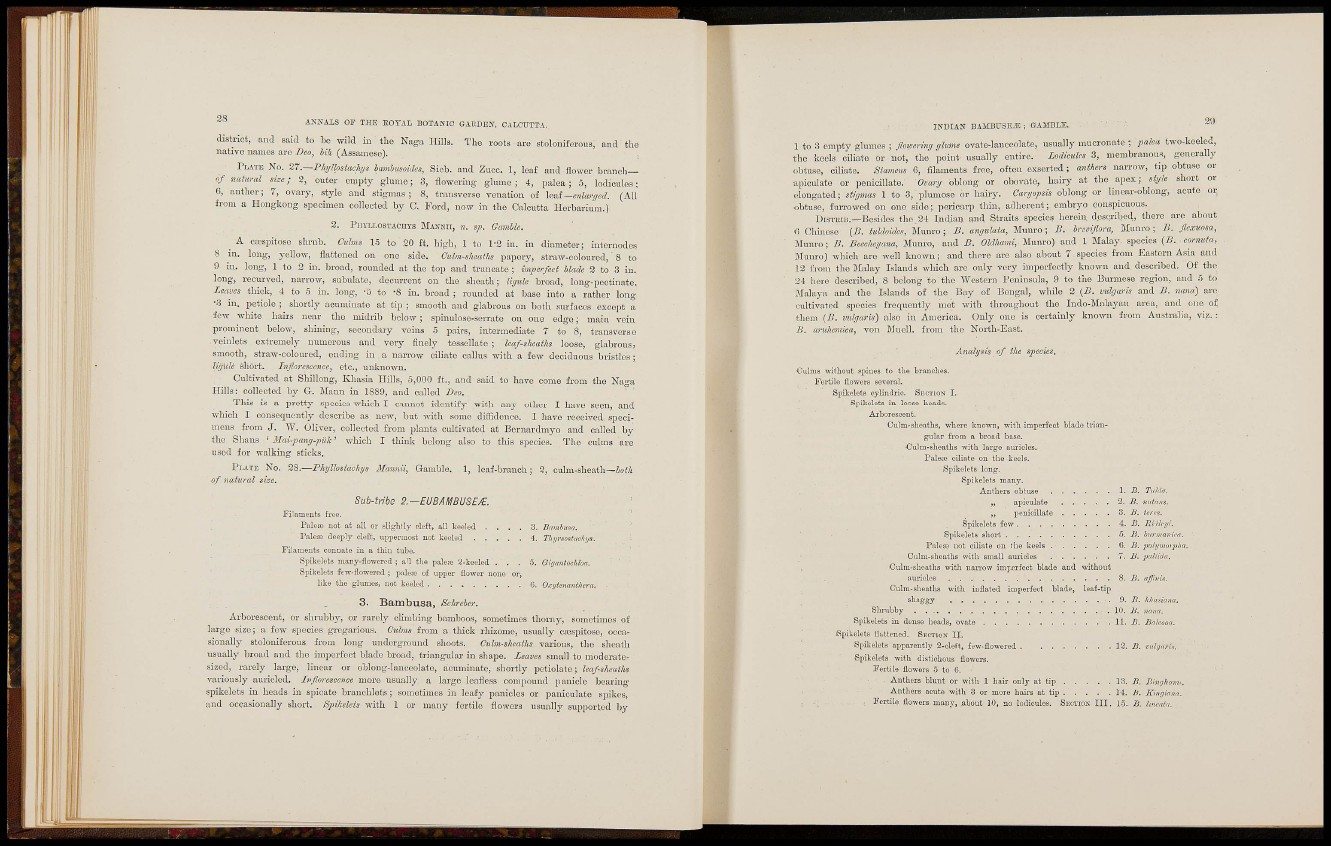
AN^-ALS OP THE EOYAL BOTANIC GARDEN. CALCUTTA.
district, and said to be wild in the Naga Hills. The roots are stoloniferous, and the
native uamos aro Deo, Uh (Assamese).
PLATE NO. 27.^Phyllostachys lamhmides, Siob. and Zucc. leaf and flower branch—
of natural size; 2, oiitej- empty glume; 3, flowering ghimo; 4, palea; 5, lodicules;
6, anther; 7, ovary, stylo and stigmas; 8, transverse venation of \<iQ.i-onlanjed. (All
from a Hongkong specimen collected by G. Ford, now in the Calciitta Herbarium.)
2. PHYLLOSTACHYS MANNII, n. sp. Gamlle.
^ A CEcspitosG sln-ub. Culms 15 to 20 ft. high, 1 to 1-3 in. in diameter; internodes
8 in. long, yellow, flattened on one side. Culm-sheaths papery, straw-coloured, 8 to
9 in. long, 1 to 2 in. broad, rounded at the top and truncate; imperfect Made 2 to 3 in.
long, recurved, narrow, subulate, decurrent on the sheath; ligtUe broad, long-pectinate.
Leaves thick, 4 to 5 in. long, -o to '8 in. broad ; rounded at base into a rather long
•3 in. petiole ; shortly acuminate at tip ; smooth and glabrous on both surfaces except a
few wliite hairs near tho midrib below; spinulose-serrate on one edge; main vein
prominent below, shining, secondary veins o pairs, intermediate 7 to 8, transverse
veinlets extremely numerous and very finely tessellate; leaf-shoaths loose, glabrous,
smooth, straw-coloured, ending in a narrow ciliate callus with a few deciduous bristles;
li[/ule short. Inflorescence, etc., unknown.
Cultivated at Shillong, Khasia Hills, 5,000 ft., and said to have come from the Naga
Hills: collected by G-. Mann in 1889, and called Deo.
This is a pretty species which I cannot identify with any other I have seen, and
which I consequently describe as new, but with some diffidence. I have received specimens
fi-om J. W. Oliver, collected from plants cultivated at Bernardmyo and called by
the Shans ^ 3Iai-pang-pUk^ which I think belong also to tins specics. The culms are
used for walking sticks.
PLATE NO. 2S,.—Phijllostachys Mannii, Gamble. 1, leaf-branch; 2, culm-sheath—Soii
of natural size.
Sub-tribe 2.—EUBAI\/IBUSEJE.
Filaments free.
Palese not at all or slightly cleft, all keeled . . . . 3. Damhim.
Pale® deeply cleft, upper most not keeled 4. Thyrsostaobyi.
Filaments connate in a tliin tube.
Spikelets many-flowered; all the palera 2-keeled . . . 5. Gigantoohha.
Spikelets few-flowered ; paleeD of upper flower rone or,
like the glumes, not keeled 6. Oxytenanthera. •
3. Bambusa, Schrebe-r.
Arborescent, or shrubby, or rarely chnibing bamboos, sometimes thorny, sometimes of
largo size; a few species gregarious. Ctdma from a thick rliizome, usually casspitoso, occasionally
stoloniferous from long underground shoots. Culm-slicaths various, the sheath
usually broad and the imperfcct blade broad, triangular in shape. Leaves small to moderatesized,
rarely large, linear or oblong-lanceolate, acuminate, shortly petiolato; leafsheuths
variously auricled. Ivfloreseence more usually a large leafless compound panicle bearing
spikelets in heads in spicate branchlets; sometimes in leafy panicles or paniculate spikes,
and occasionally short. Spikelets with 1 or many fertile flowers usually supported by
INDIAN BAMBTTSE^; GAMBLE. ^^
1 to 3 empty glumes ; flowering glume ovate-lanceolate, usually mucronate ; paha two-keeled,
the keels ciliate or not, the point usually entire. Lodiculos 3, membranous, generally
obtuse, ciliate. Stamens 6, filaments free, often exserted; anthers narrow, tip obtuse or
apiculate or penicillate. Ovary oblong or obovato, hairy at the apex; style short or
elongated; stigmas 1 to 3, plumose or hairy. Caryopsis oblong or Hnear-oblong, acute or
obtuse, furrowed on one side; pericarp thin, adherent; embryo conspicuous.
DrsTKiii.—Besides the.24 Indian and Straits species herein described, there are about
fi Chinese {B. tuldoidcs, Munro; B. angulata, Jlunro; B. Ireviflora, Munro; B. Jlexuosa,
Munro; B. Bcecheyana, Munro, and B. Oldhami, Slunro) and 1 JIalay. species {B. cornuta,
JIunro) which are well known; and there are also about 7 spccies from Eastern Asia and
12 from the Malay Islands which are only very imperfectly known and described. Of the
24 liere described, 8 belong to the Western Peninsula, 9 to the Burmese region, and 5 to
Malaya and the Islands of the Bay of Bengal, while 2 (JS. vulgaris and B. nana) are
cultivated species frequently met with throughout tho Indo-Malayan. area, and one of
them [B. vulgaris) also in America. Only one is certainly known from Australia, viz.:
B. aruhmica, von Muell. from tho North-East.
Analysis of the spccies.
Culms without spines to the branches.
Fertile flowers several.
Spikelets cyliiidrio. SECTION I.
Spikelets in loose heads.
Arborescent.
Culm-sheaths, wliere known, with imperfect blade triangular
from a broad base.
Culm-sheaths with large auricles.
Palero ciliate on the keels.
Spikelets long.
Spikelets many.
Anthers obtuse 1. B. TMa.
„ apiculate . . . . . 2. nutnns.
„ penicillate 3. terea.
Spikelets few 4. -S. RUkyi.
Spikelets short B. hirmamcn.
Palea) not ciliate on the keels 6. i?. poiipnuipha.
Culm-sheaths with small auricles 7. B. ixdHda.
Culm-sheaths with nan-ow imperfect blade and without
auricles Z. B. affinh.
Culm-sheatbs with inflated imperfect blade, leaf-tip
shaggy 9. B. lihawina.
Shrubby . . 10. i/. mma.
Spikelets in dense heads, ovate 11. ii. Balcooa.
Spikelets flattened. SECTION IJ.
Spikelets apparently 2-clet't, few-flowered 12. .B. vidgm-h.
Spikelets with distichous flowers.
Fertile flowers 5 to 6.
Anthers blunt or with 1 hair only at tip 13. B. Bmijhani/..
Anthers acute with 8 or more hairs at tip 14. B. Kinginnn.
• Fertile flowers many, .about 10, no lodicules. SECXIOK I I I . 15. B. Uncniu.